
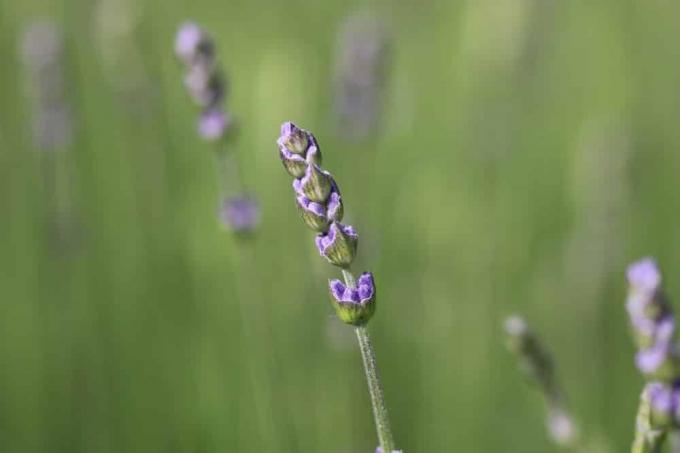
Table of contents
- Frost hardiness by zones
- Difference: frost hardy and winter hardy
- Lavandula angustifolia
- Winter care of Lavandula angustifolia
- Lavandula stoechas
- Hibernation error
- Pests and diseases in winter quarters
The genus "Lavendula" includes up to 37 different species, which are mainly found in warm regions such as the Mediterranean, Africa and in southern Asia to India. A few species such as "Lavandula angustifolia" can overwinter here, other species, such as French lavender, require separate locations in winter that must be frost-free. With a little care, every lavender will survive the winter months.
Frost hardiness by zones
In order for the lavender plants to get the right care during the cold winter months, it is important to know which species it is or which species it is. how frost hardy the plants are. Unfortunately, this information is usually very imprecise for commercially available plants, which is why attempts are now being made to develop a uniform definition. For this purpose, the so-called winter hardiness zones were defined, which makes it possible to make general statements about the winter hardiness of plants. At the same time, suitable measures such as creating a microclimate can be taken to get the lavender plants through the winter.
Zones 4 – 11 dominate in Central Europe, which means a temperature range of -34.5 – +4.4°C. For example, Lavandula angustifolia is frost-resistant up to zone 5, which means a minimum temperature resistance of down to -28.8°C. However, in this case, suitable protective measures for plants on the balcony must still be taken.
Difference: frost hardy and winter hardy
Frost hardiness and winter hardiness are now used as synonyms. However, hardiness usually includes some other properties. This also includes resistance to extreme temperature fluctuations, strong winds or strong winds. drought and frost. When buying, you should therefore pay close attention to the temperature zone for which the species is suitable or suitable. what precautions to take in the cold season.
Lavandula angustifolia

Lavandula angustifolia or True lavender is the lavender used in perfumery. It originally comes from the Mediterranean area, but was brought north by monks in the Middle Ages. There it can be overwintered outdoors in sheltered locations. Nevertheless, it needs special treatment, especially when cultivated in a pot. In winter, there is a high risk that it will otherwise dry up or the root system will be damaged by frost, since it has no opportunity to root in deep soil layers. Therefore, the root system must be protected in particular.
Prepare real lavender:
- last pruning in early autumn
- at the first frost, wrap pots with bubble wrap, straw mats, coconut mats
- use wood or styrofoam as a base
The wrapping around the pots can easily extend far beyond the edge of the pot. However, the plants should still get at least indirect light. Bubble wrap is now being used more frequently because the air-filled chambers insulate very well. The film also has the advantage that it allows light to pass through and does not offer any target for pests that can nest in natural materials such as coconut or straw. In addition, the film is also weather-resistant and can be used much longer than natural materials.
Tip:
A blanket of snow would offer optimal winter protection. When it snows, lavender plants can be loosely covered with snow.
Winter care of Lavandula angustifolia
Although Lavandula angustifolia can be overwintered outdoors, care should be taken to ensure a sheltered location. This should have a constant temperature, without extremes such as direct sunlight. Temperature extremes can lead to additional stress, causing the plants to lose too much vigour, making them unable to withstand the frost. In addition, the location should be protected from the wind, especially the particularly cold east wind.
Maintenance measures at a glance:
- regularly check humidity
- water moderately
- Remove dead plant parts regularly to prevent mold growth
Tip:
The right supply of water is often a problem during the winter on the balcony. Pots made of terracotta or clay granulate can bind excess water well and gradually release it back into the substrate.
Lavandula stoechas
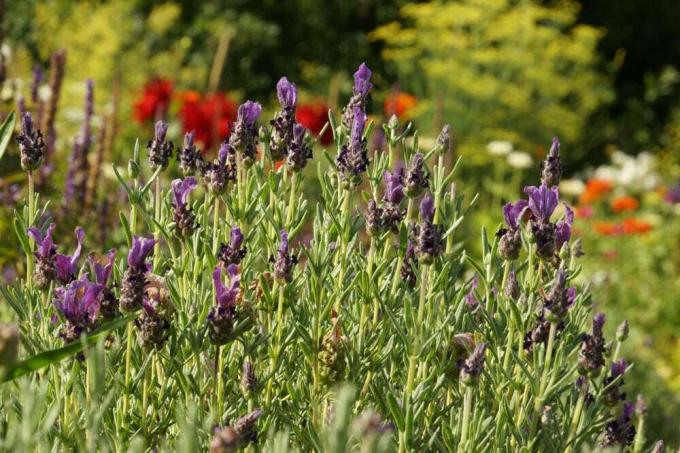
Lavandula stoechas, also known by the German name "Schopf-Lavender" is also a popular ornamental plant on the balcony. This species got its name from the inflorescences that sprout like a tuft from the top of the inflorescences. The French lavender is originally native to southern Europe and even occurs on the Canary Islands. He is an absolute lover of warmth and also specializes in dry and warm locations. This species must be overwintered frost-free.
Prepare Lavandula stoechas:
* vigorous pruning in early autumn
* If necessary, repot in early autumn
* Find location (conservatory, basement)
Tip:
If the roots are slightly shortened when repotting, this promotes root formation. This makes it easier for them to survive the winter months and sprout stronger next spring.
If the lavender is repotted, it must not be watered too much in the first few weeks when it is still outdoors. Too much water reduces root formation. In addition, a lot of moisture promotes the formation of fungi, which have good opportunities to attack the open interfaces. When overwintering the French lavender, it must be watered regularly. However, there must be no waterlogging. As a rule, it is sufficient if the plants are watered moderately once a week. Fertilization can be dispensed with in winter. Only in the last few weeks, before the plants go outside again, can you start with a weak fertilization in the form of liquid fertilizer. This promotes a strong budding.
Hibernation error
Regardless of the species, gross mistakes are made again and again during the winter, causing the plants to die. These mainly include the wrong pruning and watering. The plants are cut in early autumn, but only parts of the plant that would die anyway are removed. This mainly includes the inflorescences. The pruning also serves to ensure that the plants do not have to take care of too many leaves in winter. This would unnecessarily cost the plant energy. However, the pruning must not go into woody parts.
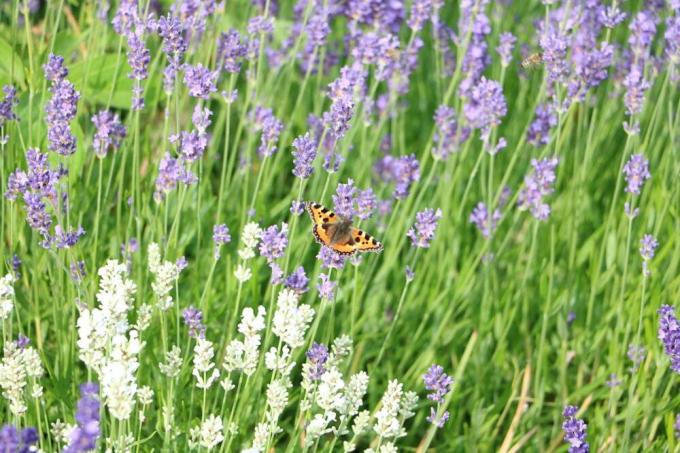
Another common mistake is heated winter quarters. Since the plants get by with little water, but appreciate the warmth, the warm temperatures lead to premature budding. This would not be a problem, but the plants lack sufficient light. There are too few hours of sunshine, which means that the shoots wither again and the plant often dies off completely.
Requirements for the winter quarters:
- bright
- Frost free
- no constant heating
- temperature: approx. 10°C
Incorrect watering behavior is the second cause that causes the plants to die off. Either too much or too little is poured. If species are overwintered outdoors, the substrate must also be kept moist. If you spend the winter inside, there is often a risk of waterlogging, which must also be avoided.
Tip:
To prevent waterlogging, place the pots on small blocks of wood in the coasters. This allows excess water to run off and you can see immediately if you have given too much water.
Pests and diseases in winter quarters
Another mistake is that the plants are not checked enough in winter. Although pests rarely attack lavender, infestations can occur indoors in winter quarters. In addition, the temperatures favor the formation of mold. In order for problems to be identified in good time, the plants must be checked regularly. In the event of pests or diseases, you must react quickly, otherwise the plants will not survive the winter. Home remedies such as a herbal decoction made from stinging nettles, which can also be prepared from the dried herb, often help with pest infestation. In the event of fungal infestation, especially if this affects the roots, the plants must be freed from the previous substrate immediately. The roots are then washed off and planted in fresh substrate and a new pot. The substrate, on the other hand, is kept only moderately moist.
 garden editorial
garden editorial I write about everything that interests me in my garden.
Learn more about overwintering plants
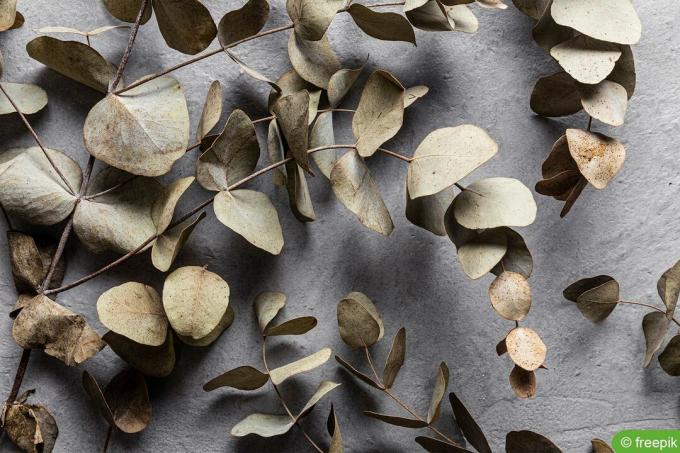
Eucalyptus dries up during the winter: what to do?
Eucalyptus in tubs spends the winter best in a frost-protected place in the house. It is not uncommon for the beautiful eucalyptus plants to dry up during the winter. We show what you can do about it.

Is bamboo hardy? Hibernate bamboo correctly
A bamboo can undoubtedly enrich any garden. But can it survive winter temperatures in good health? There is no general answer. It depends on the species and what winter protection it gets.
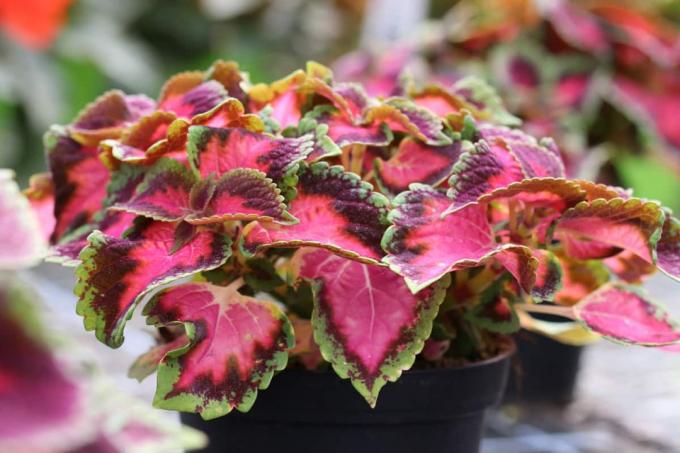
Is the colored nettle hardy? 6 tips for wintering
Summer is the season when the colors of these ornamental foliage plants are at their most intense. Most of the leaves are multicolored, with different drawings, wavy or heavily slit edges.

Is Camellia japonica hardy? Overwinter camellia properly
Anyone who sees a blooming camellia for the first time will definitely be amazed. The attractive plant, which came to Central Europe from Japan and Korea, has taken the hearts of hobby gardeners by storm. It is usually cultivated in tubs. Is she hardy?

Is the magic flower hardy? | Overwinter Mirabilis jalapa
The Japanese miracle flower (Mirabilis jalapa) delights its viewers with its bright and colorful flowers from June to October. It carries up to five different colored flowers on one and the same plant. Even a single flower can be multicolored.

Is rhododendron hardy? 6 tips for wintering
Overwintering rhododendrons: With these 6 tips you can get the azaleas through the winter safely!


